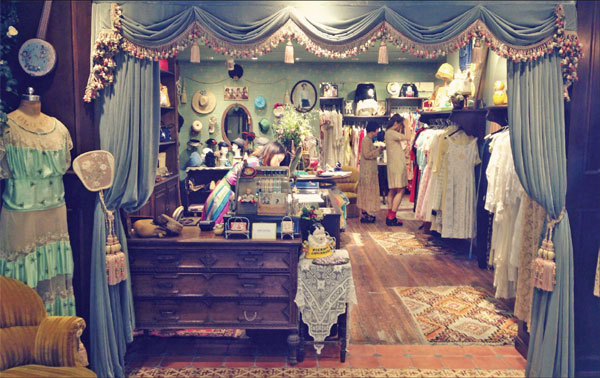Riding a wave of nostalgia

They are the people for whom old means quaint rather than decrepit, and for whom dated stuff is not just desirable, but cool as well. Hence, the Chinese version of a sign saying "Ye Olde Curiosity Shoppe" painted on an otherwise unremarkable door hidden at the end of a dark alley will have them making a beeline to see what's inside.
These are the aficionados in China of vintage clothing, part of a wider culture that celebrates the trappings of the past.
In the world of vintage fashion, it seems to be generally accepted that this past can be as recent as 35 years ago and as far back as a century ago. Furthermore, vintage clothing consists of garments whose attraction has endured, particularly clothes made between 1920 and 1980. They reflect the culture of the Western world - Europe and the United States in particular.
| Vintage shops are popularizing the vintage culture. The Lolo Love Vintage in Shanghai. Photos Provided to China Daily |
They will have been all the rage at a particular time, and even if they once disappeared, that was simply a hiatus, as they have made a comeback on a wave of nostalgia.
Vintage culture has had a steady presence in China, and although it has never completely taken hold among a wide audience, it holds a certain charm for many.
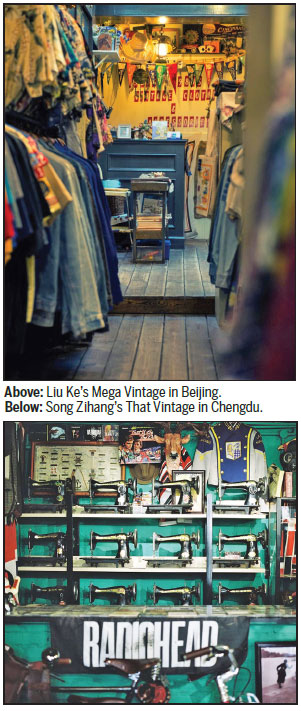
After years of working as a fashion stylist, Luo Luo, 41, says she became sick of the commercial imperatives of a job in which she had to pander to the aesthetic of the masses. She eventually gave up all her commercial assignments and opened a shop named Lolo Love Vintage.
"I didn't open the shop to make money. I did so because I love vintage clothing culture. I never lose sight of that original motivation. I work in the shop, and that means my personal preferences come first."
Liu Ke, 32, the founder of two Mega Vintage shops in Beijing, one on the fifth floor of a building in the fashionable Sanlitun area and the other in the Gulou area, has a similar ethos.
"Obviously, I always follow my personal tastes. Just look at how awful the mass aesthetic is."
Lau Hiufai, 39, owner of Delia vintage shop in Wudaoying Hutong in the Dongcheng district of Beijing, says he considers it his personal storage room.
Song Zihang, 27, owner of That Vintage Shop in Chengdu, Sichuan province, says vintage shops in different areas are little different from one another, even if the approach the owner takes can give each shop distinct characteristics.
Luo Luo, whose shop sells women's wear, says it is the historical culture behind the vintage clothing that particularly holds her interest.
She has read a pile of books about vintage clothing, she says, but the help they offer is limited. The best way to learn is by doing, which in this case means buying vintage clothing overseas, touching clothes with your own hands and talking with those who have been in the business for many years, often decades.
Vintage clothes from the 1920s to 1940s are her personal favorite, and she could talk about them for hours on end, she says.
She loves the 1920s as an era in which modernization was rapid.
"The stock market thrived, many home appliances became available and a lot of women flooded into cities from the country. They worked, they drank and they smoked, and they hung out in the same places as men."
Many people find clothing from the 1920s, like that in the movie The Great Gatsby, highly attractive, she says.
The 1920s gave women a chance to loosen up, she says. They discarded their corsets and even became a bit boyish, and the open, relaxed social environment added to the huge sense of fun.
She is also fascinated by what she regards as the refeminization of clothing in the 1930s, when women's figures were highlighted by the likes of a tight waist and a close-fitting umbrella skirt.
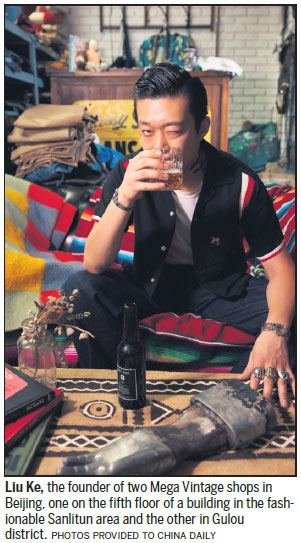
She lauds this shift to minimalism and the move to make clothing tighter fitting in the 1940s. Fabric and other materials were scarce during World War II, and silk and satin, popular in the 1930s, were replaced by mundane materials, and design features such as flouncing all but disappeared.
"With more simple designs and fewer materials available, designers paid a lot of attention to cut. Clothing changed to be very slim, and shoulder pads and false two-piece dresses came out. Clothing was in many cases influenced by military uniforms, so the vintage stuff from that era comes across as cool, with a touch of the domineering."
Apart from financial considerations playing a secondary role in the way many vintage shop owners seem to approach their business, the owners differ from orthodox retailers who will generally want a big, bold logo that shouts for attention.
Luo Luo says she would never want to have a shop in a commercial block.
"My first location was an art area, with lots of studios around the place. The second was hidden down a tiny alley. I'm now in the French Concession area. There are many old European and French-style houses around, and the block is just beautiful, with many small shops hidden inside."
In fact, to gain access to her find-me-if-you-can establishment, you have to push open a blue door that is as unimposing as a door can be.
"Vintage is niche after all. If my shop is in a commercial block, 80 percent of the visitors who come into the shop just can't get the value of the clothes on my shelf. Sure, I am keen to popularize vintage culture, but it's also important that for my customers, the shopping space is comfortable."
Song says she would advise against a vintage culture shop being in any place where there is a lot of foot traffic. Still, it is important that the shop be located where it is accessible and easy to find, she says.
"Of course, a shopping center with a retro vibe would be great." 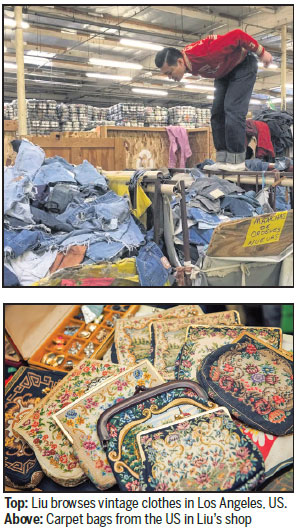
However, Lau of Delia in Beijing believes that, just as a wine can be judged by its bouquet, the aficionados of vintage culture will easily be able to sniff out the outlet they are looking for.
His shop is in a hutong called Wudaoying and is graced with a navy blue door and a sign whose lettering is so small it would not be out of place at the bottom of an optician's reading chart. In short, to find Delia, you really need to be looking for it.
Lau says he opened the shop six years ago after taking over space left vacant by a friend.
"Wudaoying used to be a quiet hutong, and I didn't give that much thought to whether it would be ideal for a vintage shop or not. I reckoned that if I put a lot of effort into growing the business, people would naturally be attracted to it."
Liu of Mega Vintage says: "It's the law of attraction; people who understand will press on to find what they are looking for."
He opened a second shop at the end of 2015 on the sixth floor of a large building in Sanlitun in Beijing, next to a coffee shop and a barber shop that he says are both furnished in a vintage style.
While that may seem like the ideal location for a vintage shop, Liu reckons he relies heavily on regular customers rather than foot traffic.
Luo Luo of Lolo Love Vintage is keen to raise the performance and the profile of the vintage clothing industry in China and has organized events with that in mind.
One of these is a retro society ball held every three months, whose aim is to give people a chance to show off their vintage clothes as they indulge in a bit of time travel.
"I hold the ball for two reasons: I want to have fun and I feel that it is my responsibility to popularize vintage culture.
"Vintage clothing is the carrier of historical culture, which is what I'm really interested in. At the root of all the events I hold is culture."
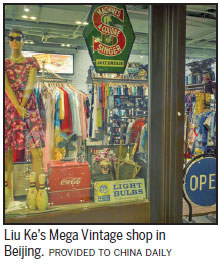
She sees the shop as a kind of Alice's Wonderland, she says.
"I wouldn't want to say it's a space disconnected from the world, because for me it's a dreamland and reality as well."
Liu is a little more hard-edged in his thinking, considering vintage clothing as resistance to reality.
"We make fun of mainstream culture and subvert it, and we couldn't care less about reality. That's because reality is the cruelest restriction you can impose on us."
One reason people appreciate vintage clothing is that it brings beauty from the past into their current reality, Liu says.
"We are immersed in the past and in old culture. We are developing a lifestyle."
xuhaoyu@chinadaily.com.cn
(China Daily European Weekly 09/29/2017 page1)
Today's Top News
- Nation capable of sustaining trade growth
- Sovereign wealth funds ramping up allocation to Chinese assets
- Common ground prevails over differences: China Daily editorial
- China's foreign trade up 2.9% in H1
- Task force formed to probe lead exposure
- Albanese's visit shows close economic links
















